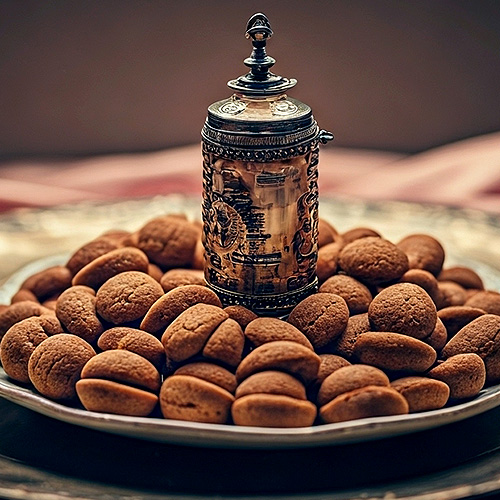
Pepernoten: A Bite of Dutch History
Pepernoten have a long-standing place in Dutch holiday traditions, especially during the festive celebration of Sinterklaas, which takes place on December 5th. But these little cookies are more than just seasonal sweets, they carry centuries of history and cultural meaning.
The tradition of giving out pepernoten dates back to the 16th or 17th century in the Netherlands. During Sinterklaasavond (St. Nicholas Eve), Sinterklaas and his helpers (historically known as Zwarte Piet, now often referred to as “de Pieten”) would toss handfuls of pepernoten into crowds or children’s shoes, a playful gesture meant to represent generosity, abundance, and the unpredictability of fortune.
This custom is tied to old tales of Saint Nicholas throwing coins into the homes of the needy, a symbol of kindness and surprise, which evolved into the throwing of treats.
Spices from the East
The name pepernoten literally means “pepper nuts,” which hints at the use of exotic spices, cinnamon, cloves, nutmeg, and pepper — introduced to the Dutch during their Golden Age of trade in the 17th century. The Dutch East India Company (VOC) brought back spices from Indonesia and the East Indies, which became a hallmark of Dutch holiday baking. Cookies like pepernoten were once considered luxurious due to these rare and costly spices, making them extra special for the winter season.
More Than Just a Cookie
The original pepernoten have become less common, as kruidnoten (with their crunch and spice) gained popularity. Still, both remain an essential part of Dutch holiday celebrations, often available in dozens of flavors (chocolate, truffle, caramel sea salt) in Dutch supermarkets each fall. Pepernoten Cookies is a delicious way to connect with a bit of Dutch history and celebrate the warmth of winter traditions.
Pepernoten vs. Kruidnoten: Why Everyone Mixes Them Up
Let’s clear something up right away: pepernoten and kruidnoten are not the same cookie. I know even in the Netherlands people mix them up all the time. You’ll often hear someone call the crunchy little spice bombs “pepernoten,” but technically, they’re talking about kruidnoten. Confusing? Totally. Delicious either way? Absolutely.
The real difference
Pepernoten are the OG holiday treat. They’re soft, slightly chewy, and kind of lumpy in a charming, rustic way. Traditionally made with rye flour, honey, and a hint of anise, they taste like a cozy bite of spiced bread — less sweet, more nostalgic. Think old-school Sinterklaas vibes and childhood memories wrapped in parchment paper.
Kruidnoten, by contrast, are the crisp, poppable spice cookies that flood Dutch supermarkets every fall. Made with a heady mix of speculaaskruiden (think cinnamon, nutmeg, cloves, ginger, and pepper), they’ve got a bold, warming flavor and that satisfying crunch you can’t stop going back for. They’re more like tiny, spiced biscuits — or mini speculaas cookies.
These days, it’s the kruidnoten that take center stage during Sinterklaas season. You’ll find them dipped in chocolate, coated in truffle dust, or even stuffed with caramel. But the humble pepernoot is still out there, holding its own — softer, subtler, and steeped in tradition.
So next time someone offers you a “pepernoot,” you’ll know what you’re really eating — and maybe, just maybe, you’ll want to try baking both.
Serving
Pepernoten are best enjoyed fresh from the oven, slightly warm and soft, but they’re just as delicious at room temperature with a cup of coffee, tea, or hot chocolate. Serve them in a big bowl for sharing during Sinterklaas celebrations, or pack them in small paper cones or treat bags for a festive touch. Try dipping one side in melted dark chocolate or pairing them with a creamy Dutch advocaat.
Storage
To keep your pepernoten fresh and tasty, store them in an airtight container at room temperature, they’ll stay good for up to one week. If you want to keep them longer, pepernoten freeze beautifully! Just place them in a sealed freezer bag or container, and they’ll keep well for up to three months. When you’re ready to enjoy them, simply thaw at room temperature or warm gently in the oven for a few minutes to bring back that soft, cozy texture.













